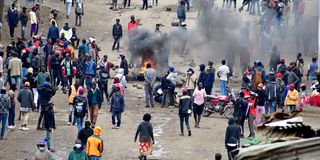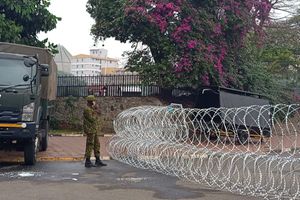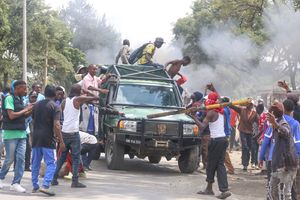
Youths lit bonfires at Kamukunji grounds during the Saba Saba protests in Nairobi on July 07, 2025.
The historic Kamukunji grounds in Nairobi, long regarded as the symbolic cradle of Kenya’s pro-democracy struggle, on Monday, stood under heavy construction and police barricades.
Yet even in its physical absence, Kamukunji’s spirit loomed large drawing thousands of Kenyans back to the streets to commemorate the 35th anniversary of Saba Saba Day in scenes charged with defiance, anger and painful echoes of the past.
Thirty-five years since Kenyans braved tear gas and bullets on July 7, 1990, to demand multiparty democracy, Kamukunji once again became the focal point of national protests, this time against high taxes, joblessness, police brutality and a perceived betrayal by both government and the Opposition.
What began as a peaceful gathering on Monday quickly spiralled into running battles after anti-riot police deployed in large numbers lobbed tear gas canisters and unleashed water cannons on crowds that had assembled along Kamukunji Road, unable to access the actual grounds now tucked away behind construction barricades.
This year’s Saba Saba commemoration carried the spirit of the 1990 protests but was driven by a new generation with fresh grievances.
High unemployment, rising cost of living, punitive taxation and deepening corruption have pushed Gen Z and grassroots activists into the streets reigniting Kenya’s long-standing struggle for justice and accountability.
But unlike previous years, no prominent Opposition leaders were present during the protests.
ODM party leader Raila Odinga, a veteran of the original Saba Saba protests, had on Sunday urged Kenyans to show up at Kamukunji, but was conspicuously absent on the day itself.
"I was going to go to Kamukunji and join Kenyans in commemorating this important day. Unfortunately, as you all know circumstances today, the roadblocks all over town which made it difficult for people to make it to Kamukunji," Mr Odinga said during a press conference In Nairobi late on Monday afternoon.
Mr Odinga called for an inclusive inter-generational national conclave to address challenges including police reforms, accountability and youth unemployment.
But the loud silence from the Opposition and other key political figures was felt deeply among protesters at Kamkukunji.
“For years, we followed the Opposition because they stood with us. But today, we are on our own. The streets are our only platform now,” said Aisha, a protester who had brought her two children to Kamukunji Road.
By midday, the tension had boiled over.
Protesters chanting freedom slogans tried to march toward Nairobi’s Central Business District, a symbolic reenactment of the original 1990 movement.
But police barricades and brute force stopped them in their tracks as mothers fled with their children and traders, on sensing the inevitable chaos, shut down their shops early.
Civil society groups had planned peaceful processions and a “People’s Assembly” to read a citizens’ charter demanding an end to excessive taxation, corruption and state violence.
But police blocked all access roads to the CBD, effectively halting, not just the march, but much of the city’s economic activity.
The tense standoff mirrored scenes from the 1990s. Parts of Jogoo Road, Landhies Road and City Stadium roundabout turned into battlegrounds as police officers pushed the protesters back into Kamukunji, Majengo and Shauri Moyo estates.
Still, demonstrators regrouped in alleyways and side streets. Amid the civil disobedience, elements of criminality crept in.
Armed youths took advantage of the chaos to rob pedestrians and loot shops along Kamukunji Road, betraying the very principles of the original Saba Saba struggle.
By 4 pm, the area was deserted with fires burned out with spent tear gas canisters, scattered stones and shattered glass littering the streets of Kamukunji.
Elsewhere In Kangemi, Kitengela, and Ngong, similar scenes of unrest played out. Reports of arbitrary arrests, injuries, and even deaths filtered in by evening.
However, the events of Monday, compared to recent protests, remained largely free from large-scale bloodshed.






